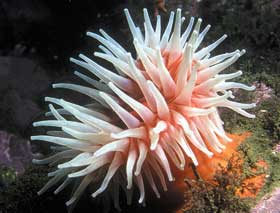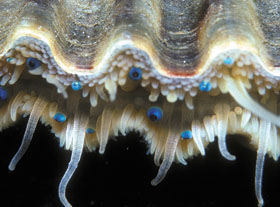  |
| HOME | THIS ISSUE | CALENDAR | GRANTS | BACK ISSUES | < BACK | NEXT > |
Underwater habitats featured on Long Island Sound websiteby Cindy Weiss - April 9, 2007 | ||||||
| A new website showing what is beneath the waves of Long Island Sound may surprise beachgoers and boaters alike. Nestled in the sand and rocks below the surface are red beard sponges, soft pink coral, and the bright scarlet blood star, or starfish, as it is popularly known. The colorful display might be expected in the tropics, but it’s on the sea floor off Connecticut, too, along with the American lobster, clamshells, and bay scallops. The display can be seen in color photos and videos at www.lisrc.uconn.edu/lis_uwtour a new website developed by Peter Auster and Ralph Lewis, both faculty members in the Department of Marine Sciences, with a grant from the Long Island Sound Fund of the Connecticut Department of Environmental Protection (DEP). The project is a collaboration between the University’s National Undersea Research Center (NURC) and the Long Island Sound Resource Center, a partnership of UConn and the DEP. The underwater photos were taken during research and exploratory dives in Long Island Sound by University researchers and collaborators over the past 30 years. The most recent expedition was on UConn’s RV Connecticut and was led by Auster. A remotely operated vehicle with state-of-the-art video equipment was used in deep water to survey habitats in three areas rarely visited by humans. Auster, who is also science director of the NURC, says the website reflects the variety of species that call Long Island Sound “home” – 1,200 invertebrates and 170 species of fish, along with marine mammals, sea birds, and sea turtles. “Most people have no idea that the biological diversity is so high,” says Auster. More than 1,000 digital images have been scanned into a digital archive, and about 400 are now available on the site. More images from the archive will be added to the site, as well as new ones taken during future research cruises.
Besides an underwater tour, the site describes the habitats in the Sound, its history and geology, and how its environment is affected by human activity. The website will be used to teach school children, to educate fishermen, boaters, and the public, and to increase appreciation for the beauty of an underwater world that is not seen from the surface. | ||||||
| ADVANCE HOME UCONN HOME |



